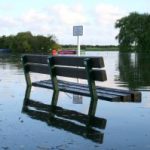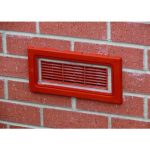There are several things you can do to protect your home from flooding. All of the measures explained here can be done yourself, fairly quickly, for relatively small amounts of money when compared to the potential cost of flood damage to your property.
The increase in flood events, such as those in 2014 which saw much of the UK under water, has prompted the construction of large-scale flood prevention schemes in many parts of the country. But whilst some areas are deemed important enough for the powers that be to protect, others are being left with the threat of flood hanging over them. But that doesn’t mean that you have to simply sit back and accept the rising of the waters.
Using Sandbags
 Images of councils and even the army handing out sandbags to flood-hit residents were all over the news at the beginning of 2014. But whilst in the event of a serious flood, sandbags will probably be provided by government agencies, don’t assume they will be. And even if they are provided, they will need to be shared with every household in your street, and demand will almost certainly outstrip supply.
Images of councils and even the army handing out sandbags to flood-hit residents were all over the news at the beginning of 2014. But whilst in the event of a serious flood, sandbags will probably be provided by government agencies, don’t assume they will be. And even if they are provided, they will need to be shared with every household in your street, and demand will almost certainly outstrip supply.
Whilst it is unlikely that you have the space to store enough sandbags to encircle your entire house to a height of three feet, there is no reason why you can’t stockpile enough of your own sandbags to protect your doors, or even your driveway and other gaps in your garden wall. You should also try to protect drains to prevent water backing up through them if you don’t have non-return valves fitted. You can buy packs of empty sandbags from B&Q and several other DIY retailers. Buy a hopper of sand from a builders merchant and spend a weekend filling bags and stacking them somewhere out of the way, ready to be used when the heavens open.
Sandbags are available in several materials, from finely woven plastic to hessian and even canvas. The material of the bag is not as important as the sand inside, as it is this which ultimately stops the water. It is best to use ordinary builders sand to fill them (and they should be filled as fully as possible). When laying sandbags, overlap them as if building a brick wall, treading down each layer to compress the sand and fill gaps.
Along with the sandbags, it is worth buying some sheets of plastic or polythene to lay on the ground beneath the bags. This will help to create a better waterproof seal between the sandbags and the ground. This can also be pulled up to cover the outer face of the sandbag wall, giving even better protection. In an emergency, you can improvise sandbags using bin liners (doubled up) filled with either sand, if available, or garden soil. Just remember that a bin liner filled with soil will weight a considerable amount, so try to fill them as close as possible to where you need them.
Installing Flood Shields
These are sheets of wood, plastic or even metal, cut to the width of your doorways and held in place by channels fixed inside the door recess. When flooding looks likely, the sheet of material is slotted into the channels to create an extra barrier directly in front of the door. The channels that the shields slot into should have rubber strips down the full length to help stop water seeping through.
Whilst the shield itself can be removed when not needed, the channels have to remain in place, which isn’t the most attractive feature you could attach to your home. However, if they stop water making its way into your home, most people would be happy to lose a bit of curb appeal on their property. Flood shields are now widely available to buy, and range from less than £10 to several hundred pounds, depending on the quality of the material, size and how it is attached to the wall.
Fitting Airbrick Covers
 Because airbricks are normally placed quite low down in a wall, a flood doesn’t have to be metres high for the water to find its way in. An airbrick will either provide water with a direct channel into your house, or it will let water fill the cavity between the brickwork. Both scenarios are something you really want to avoid.
Because airbricks are normally placed quite low down in a wall, a flood doesn’t have to be metres high for the water to find its way in. An airbrick will either provide water with a direct channel into your house, or it will let water fill the cavity between the brickwork. Both scenarios are something you really want to avoid.
There are several different types of airbrick flood protection covers available to buy, from simple single-use sheets of waterproof rubber which are stuck over the airbrick with strong adhesive, to plastic frames which are screwed to wall around the brick, with shields which can be quickly slotted into the frame as and when needed.
Fitting Non-return Valves
Non-return valves can be fitted to several different types of plumbing pipe and are designed to stop water being forced back up a pipe and into a property in the event of a flood. As the name suggests, the valve is fitted so waste water can flow out normally, but closes if water starts to flow the other way (return). While it is fairly obvious that doorways and airbricks need to be blocked to prevent flood water entering, it is easy to forget about the numerous drainage pipes which can allow surprisingly large amounts of water into your home.
It is possible to fit non-return valves yourself, although it won’t be a job that everyone will want to tackle. In this case, any competent plumber or drainage contractor will be able to do the job reasonably cheaply.
Water Pumps
Although this might seem like a drastic measure, having your own water pump capable of pumping both clean and dirty water, should be a serious consideration for anyone living in a flood-prone area. Water pumps can be used to remove water which has seeped through sandbag defences outside, or used to keep the water level down if your home has been breached. This can be a short-term way to protect your home from flooding.
There are several different types of domestic-use water pumps available, at a variety of prices ranging from less the £50 to well over a thousand pounds. As you might expect, a cheap £50 pump will not be able to handle huge (or even large) amounts of water, but even a low-capacity pump could mean the difference between a close call and a disaster if the flood is fairly minor. For a basic submersible clean and dirty water pump, expect to pay around £90-£100. A basic petrol driven water pump can be had for around £170-£250.
Flood Warnings
It is no good preparing for a flood if it happens in the middle of the night and the first thing you known about it is when you wake up to an indoor swimming pool in your kitchen. The government advice website, www.gov.uk, allows UK residents to sign up for free flood warnings. You will need to provide an address, phone number that you can be reached on day or night, and an email address. If the address given is at risk of flooding, a warning can be given by phone, email or sms message.
Advanced Flood Protection
No house can be made completely flood-proof, but if you live in an area very prone to flooding, there are several advanced (and potentially very expensive) measures you can take to make your home both better protected from serious floods, and easier to sort out if water does enter in large quantity. The measures shown here should mostly be carried out by professionals. Speak to a qualified surveyor or flood protection company to see which would be suitable for your home.
-
Tanking rooms to prevent water seeping up through the floor.
-
Raising the height of the damp-proof course.
-
Raising the level of exterior doorway thresholds.
-
Raising the level of ground floor electrical sockets to 1.5m.
-
Rewiring from the ceiling down, rather than the floor up.
-
Replacing wooden windows and doors with synthetic versions (uPVC).
-
Fitting water-resistant skirting boards.
-
Fix electrical equipment to walls (TV’s, Stereos) about 1.5m.
-
Replace chipboard kitchen units with solid wood, steel or other waterproof material.
-
Fit a submersible water pump under the floorboards or in the basement.







